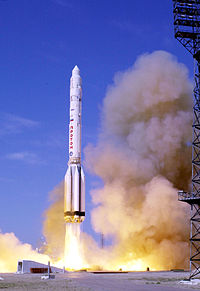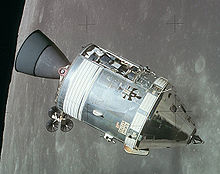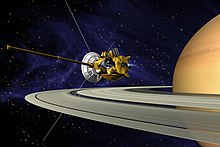Spacecraft
A spacecraft is a vehicle or machine designed to fly in outer space. Spacecraft, a type of artificial satellite, are used for a variety of purposes, including communications, Earth observation, meteorology, navigation, space colonization, planetary exploration, and transportation of humans and cargo. All spacecraft except single stage-to-orbit vehicles cannot enter space on their own and require a launch vehicle (carrier rocket).
In suborbital spaceflight, a spacecraft enters space and then returns to the surface, without having gained enough power or speed to make one full orbit of Earth. For orbital spaceflight, spacecraft go into closed orbits around Earth or other celestial bodies. Spacecraft used for human spaceflight carry people on board as crew or passengers from the start or into orbit (space stations) only, while those used for robotic space missions operate autonomously or telerobotic. The robotic spacecraft used to support scientific research are space probes. Robotic spacecraft that remain in orbit around a planetary body are artificial satellites. To date, only a handful of interstellar probes, such as Pioneer 10 and 11, Voyager 1 and 2, and New Horizons, are on trajectories out of the Solar System.
The orbital spacecraft may or may not be recoverable. Most are not. Recoverable spacecraft can be further subdivided by the Earth reentry method into non-winged space capsules and winged space planes.
Humanity has achieved space flight, but only a few nations have the technology for orbital launches: Russia (RSA or "Roscosmos"), the United States (NASA), the member states of the European Space Agency (ESA), Japan (JAXA), China (CNSA), India (ISRO), Taiwan (Chung-Shan National Institute of Science and Technology, Taiwan National Space Organization (NSPO),) Israel (ISA), Iran (ISA) and North Korea (NADA).
First ideas
Although the idea of space travel dates back at least to the time of the ancient Roman Empire, the same is not true of the concept of "spacecraft", as the human imagination was severely conditioned by the lack of technological development. Authors such as Plutarch in the I (De facie in orbe lunae) century, and Kepler in the 17th century (Somnium) mention trips to the Moon, though unable to conceive of an artifact capable of making the trip, using hidden paths or the intervention of spirits.
The first non-magical attempts to reach space appear in the second half of the 18th century, using the precarious methods available at the time. Thus, in The Adventures of Baron Munchausen the Moon is reached in a balloon. However, this story still belongs to the genre of epic fantasy. The leap from fantasy to science fiction will take place almost a century later, in the famous From the Earth to the Moon, published by Jules Verne in 1865, in which a gigantic ballistic cannon is used, back to the moon. In this novel the author already tries to solve some of the problems of his method of travel, such as the lack of oxygen outside the atmosphere or the compensation for the immense acceleration of takeoff.
Years later, H. G. Wells would continue using the cannon method in The War of the Worlds (1898), but in this case destined for Mars.
It is at this time, already at the beginning of the XX century, when the first realistic ideas about spaceships finally emerge.; ideas that will come associated with the jet engine. The pioneering work in this field is The Exploration of Cosmic Space by Means of Jet Engines, published by the Russian physicist Konstantin Tsiolkovsky in 1903. At this point science fiction will give way to science.
Design
Spacecraft design encompasses both unmanned or robotic craft (satellites and probes) and manned craft (space stations, shuttles, and modules).
All spacecraft to date consist of two parts:
- Cohetes: Driver section, consisting of engines and fuel tanks, whose mission is to abandon the Earth's atmosphere and to put the ship into stable orbit.
- The ship itself, which will make the journey through space itself, and which can adopt any of the above forms.
Propulsion systems
liquid propellant, while ships can be powered by chemical, nuclear, ion or even solar sail engines.
Since for the moment chemical propulsion is the only one with references in practical reality, the examples of its use in science fiction should be assumed to be more abundant. It may have been so in the earliest science fiction, before the use of atomic fission as a power source became widespread. Actually, the dreamy minds of the writers abandoned the old rocket as a means of getting off Earth.
Even so, it has become the emblem of an entire era and authors such as Ray Bradbury, in Martian Chronicles (1950), associated it almost inextricably with his work (although it is possible that the tremendous summer heat of the rocket was not produced by combustion).
Chemical rockets have a very limited range due to their enormous mass expenditure of fuel and would be unlikely to take us much further than Mars. In fact, without being able to totally banish this type of booster, NASA is evaluating the possibility of building an electromagnetic cannon on the side of a mountain to help space shuttles take off, saving fuel and reducing the risk of accidents.
In The Moon Is A Cruel Mistress, Robert A. Heinlein, as early as 1966, uses an electromagnetic catapult to accelerate cargo from a lunar base to Earth and the same mechanism is used by Arthur C Clarke in the story Maelstrom II, from 1965. These works, far from the fantasy of throwaway magazines, attempt to address the issue of the colonization of nearby bodies with a certain scientific rigor.
Even today the idea of the cannon continues in the form of electromagnetic catapults and the so-called «atomic explosion propulsion», conceptually identical to the chemical explosion.
Spaceship Examples
Human Spacecraft
- Orbital
- In service
- International Space Station
- Shenzhou, China
- Soyuz (Russia)
- Out of service
- Spaceship Apollo
- Gemini spaceship
- Mercury Project
- Tripulada Maneuver Unit (the smallest maneuvered ship)
- Mir
- Salyut
- Burán ferry
- Skylab
- American Space Transponder
- Vosjod Programme
- Vostok programme
- Suborbital
- SpaceShip One
- X-15
Unmanned Spacecraft
Soft landing vehicle (NASA).
- Ground orbit
- Automated Transfer Vehicle (ATV)—European unmanned cargo spaceship
- Soviet Shuttle Buran (one mission, reusable)
- Explorer 1 First US satellite. U.S.
- Progress Spaceship of Soviet non-manned Charge
- SCORE First Communications Satellite Project
- SOHOSolar and Heliospheric Observatory: Solar and Heliospheric Observatory
- Sputnik 1: world's first artificial satellite
- Sputnik 2: first satellite in orbit with an animal (Laika parrot)
- Sputnik 5: first Vostok capsule recovered with survivors
- STEREO: Environmental observation of the Earth
- Syncom: first geosynchronous communications satellite
- Kepler: satellite for the search for extra-solar planets
- Lunar
- Clementine: United States Navy mission. Orbited the Moon and detected hydrogen in the poles
- Moon 1: first flight without crew to get to the moon
- Moon 2: first contact with the lunar surface
- Moon 3: early images of the dark side of the moon
- Moon 9: first Alunizaje
- Moon 10: first stable lunar orbit
- Moon 16: first collection of unmanned lunar surface samples
- Lunar Orbiter: series of successful spacecraft that mapped the Moon
- Lunar Prospector: confirms hydrogen detection at lunar poles
- SMART-1: ESA lunar impact probe
- Surveyor: First United States Alunizaje
- Chandrayaan-1: India's first lunar mission
- Interplanetary
- Cassini-Huygens: Saturn's first artificial satellite and landing on its moon Titan
- Galileo: first artificial satellite of Jupiter and probe
- Mariner 4: first approach to Mars, first close images and high resolution of Mars
- Mariner 9: Mars' first artificial satellite
- Mariner 10: first detailed photographs of Mercury
- Mars Exploration Rover: motorized probe in Mars
- Mars Global Surveyor: Artificial Satellite in Mars
- Mars Reconnaissance Orbiter: artificial climate monitor satellite in Mars
- MESSENGER: first Mercury satellite (in 2011)
- Mars Pathfinder: motorized probe in Mars
- New Horizons: first approach to Pluto (taken in 2015)
- Pioneer 10: first approach and detailed photos of Jupiter
- Pioneer 11: second to fly Jupiter and first flight near Saturn
- Pioneer Venus: first artificial satellite and Venus surface probe
- Venera 4: first controlled descent to the surface of another planet (Venus)
- Viking 1: first controlled descent to the surface of Mars
- Voyager 2: approach to Jupiter, Saturn, and first approach to Neptune and Uranus
- Others (deep space).
- Cluster
- Deep Space 1
- Deep Impact (space commission)
- Genesis
- Near Earth Asteroid Rendezvous
- Stardust
- WMAP
- The fastest spacecraft
- Helios 1 and 2 (252 792 km/h).
- The most remote spacecraft in the Sun
- Voyager 1, which in February 2018 was 141.25 AU (astronomical unit: the average distance between the Earth and the Sun) or 21.300 million kilometers, moving away at a speed close to 3.6 UA (540 million kilometers) per year. In August 2012, it became the first ship that left behind the heliopausa and entered the interstellar space.
- Pioneer 10, which in 2011 was at an estimated distance of 15.4 billion kilometers, moving away at a speed close to 2.6 UA (390 million kilometers) per year. The communications were interrupted on 23 January 2003, years after the initial schedule.
- Voyager 2, which in February 2018 was 116.75 AU, moving away at a speed close to 3.3 UA (495 million kilometers) per year.
- The Heaviest Spacecraft
- STS shuttle, NASA (with 2030 tons).
Spaceships in development/proposed
- Orion
- Kliper of Russia
- H-II transfer vehicle
- CNES Mars Netlander
- James Webb Space Telescope (demoted)
- Darwin Space Project
- Herschel Space Observatory
- Mars Science Laboratory, rover
- Terrestrial Planet Finder, probe
- Boeing X-37
- SpaceX Dragon manned ship
- System F6, broken spacecraft prototype DARPA
- Reaction Engines Skylon with Hybrid Engine
- Estatorreactor Bussard, spacecraft capable of achieving relativistic speeds.
Canceled/Unfunded Spacecraft Programs
- Multi-stage
- Project 921-3, Chinese shuttle
- Hermes Shuttle (ESA)
- Burán Shuttle (Russia)
- Soyuz Kontakt
- Teledesic
- Manned Orbital Laboratory
- X-20
- Reusable (SSTO).
- RR/British Aerospace HOTOL
- Hopper (from ESA).
- McDonnell Douglas DC-X (Delta Clipper).
- Roton, hybrid ship with rotor
- VentureStar (from Lockheed-Martin).
Fictional Spaceships
Spaceships have always been one of the banners of science fiction. The space opera would be a greatly diminished genre without the possibility of interstellar flight, and hard science fiction would be deprived of the colonization of other worlds if interplanetary travel could not be counted on.
The spaceships used in one genre or another are very different, especially in terms of their plausibility and their possibility of materialization with current technology. The degree of development of scientific knowledge at the time the work was carried out has marked the evolution of the spaceship concept and has diversified the methods of propulsion. Thus we find different types of propulsion that correspond to the level of speculation and knowledge characteristic of each author.
Some representative works that deal with the subject are:
- Julio Verne wrote From Earth to Moon in 1865
- C-57D (Planet prohibited), a ship that looks like a flying saucer
- Discovery 1 in the movie 2001: a space odyssey
- Rama in Arthur C's novels. Clarke and Gentry Lee
- Galasphere 347 in the puppet series Space Patrol
- UNSC Pillar of Autumn in the first delivery of Halo video game
- Fireball XL5 of the television series of the same name
- TARDISan unconventional spacecraft, in the television series Doctor Who.
- USS EnterpriseA ship with warp thrust in the series Star Trek.
- Millennial HawkThe Han Solo ship in the movies Star Wars.
- Prometheusin the television series Stargate SG-1
- LiberatorIn the movie Blake's 7
- NostromoIn the movie Alien.
- White Starin the television series Babylon 5.
- LEXX, a spacecraft crewed in the series of the same name
- Moya (Farscape) another manned spacecraft
- Battlestar (‘battle star’) of the television series Battlestar Galactica
- Jupiter 2 in the television series Lost in space
- GSV, a cruise/habitat aware of the series of novels The Culture
- SDF-1 in Robotech, a television series
- Macross of the animé series The Super Dimension Fortress Macross
- MegaShip series Power Rangers in Space
- Ptolema II of the anime series Gundam 00
- SSV Normandy video game Mass Effect
- Planet Express Ship of the television series Futurama
- Prometheus in the movie Prometheus (2012)
Nuclear Fission Engine
Entering the Golden Age of science fiction, most authors noted for their atomic-powered ships for their imagined voyages, reflecting the rise of that method of energy production at the time.
For example, Arthur C. Clarke's Childhood's End (1953) depicts two superpowers competing in the space race to conquer the Moon using atomic-powered spacecraft.
The fission engine greatly improves the performance of a chemical rocket and the fuel can be any boilable liquid. Since nuclear fuel should theoretically last a long time, a ship powered by such an engine could make a ten- or twelve-year journey simply by periodically refueling reaction mass.
Atomic explosion: the Orion project
Searching for a way to use atomic energy more efficiently, the Orion Project emerged, which consists of using an atomic explosion to produce plasma, which, when colliding with a plate in the space vehicle, would generate an enormous impulse.
The duration of the burst is so short that the impulse plate, made of steel or aluminum, hardly suffers a slight wear.
The result is an engine with a thrust ratio thousands of times greater than that of a chemical engine. In addition, it needs a much smaller reaction mass thanks to the high speeds reached by the plasma.
However, a small glitch in the detonation process can destroy the ship, as well as everything around it.
However, science fiction has been able to avoid these drawbacks. In the movie Deep Impact, the ship is equipped with an Orion propulsion system, and the drive plate can be seen perfectly in the ship's starting sequence.
Fusion Ships
Atomic fusion essentially consists of melting two hydrogen atoms to form helium, accompanied by a huge release of energy. The resulting particles are highly energetic and move at speeds very close to light. Therefore, that would be the theoretical limit of a ship of this type.[citation needed]
As in fission, the expelled particles that provide the reaction impulse reach very high temperatures, which is a problem when looking for materials to manufacture the nozzles. However, in fusion, the reaction can be adjusted so that its by-products are mostly charged particles, which would allow them to be channeled by electromagnetic fields.
Much of the energy released by fusion must be devoted to maintaining these fields. Even so, taking into account the biological tolerance of the human being to the acceleration (located around 10g) the fusion reactor provides more than enough energy to reach this limit.
These ships are capable of maintaining sustained accelerations of 1g, emulating artificial gravity. After less than a year, the spacecraft would be moving at a tenth of the speed of light, which is a viable option for possible interplanetary travel.
Antimatter Engines
An energy source even more powerful than fusion would be matter-antimatter annihilation. An antimatter engine would theoretically produce about 20,000 trillion joules per kilogram of fuel, which would be optimal from an energy point of view for the propulsion of a spacecraft.
In the annihilation of protons and antiprotons, pions are generated as a by-product that can be manipulated by means of magnetic fields to produce impulse. These pions move almost at the speed of light, so the final speed of these ships would also be very high.
As mentioned before, the excess energy produced can be used to propel ships much larger than the previous ones.
However, antimatter is difficult to produce and highly unstable, which complicates its use. Authors such as Joe Haldeman or Stephen Baxter have used the ruse of inventing a natural source of antimatter, but it has been more common to find the concept associated with dark and miraculous uses, as in the case of the engines of the Enterprise ship. i> (from the Star Trek series).
Wormhole
Wormholes are well known in movies, series and video games (Star Wars, Interstellar or Stargate, for example), a scientifically unproven phenomenon that makes jumps in space-time.
Warp Drives
Warp or curvature drives are a type of hypothetical drive whose future viability is discussed. They generate a distortion in the space-time fabric that surrounds the ship, so that it is not the ship that is hurtling through space at high speed, but the space itself that is stretching, carrying the ship with it. This system has the advantage that it can circumvent the limitation of the speed of light, being able in theory to reach arbitrarily high speeds. The downside is that the amount of energy required for such a trip would be disproportionate.
Sun sails
This system lacks an engine and fuel, and instead takes advantage of the solar wind or solar radiation through huge sails. There are experimental prototypes that confirm the validity of the concept, but current technology lacks the adequate materials to make this system a useful method. Even so, solar sails are used in numerous works of science fiction.
Contenido relacionado
Crowded
Mechanism (disambiguation)
Gastridium








